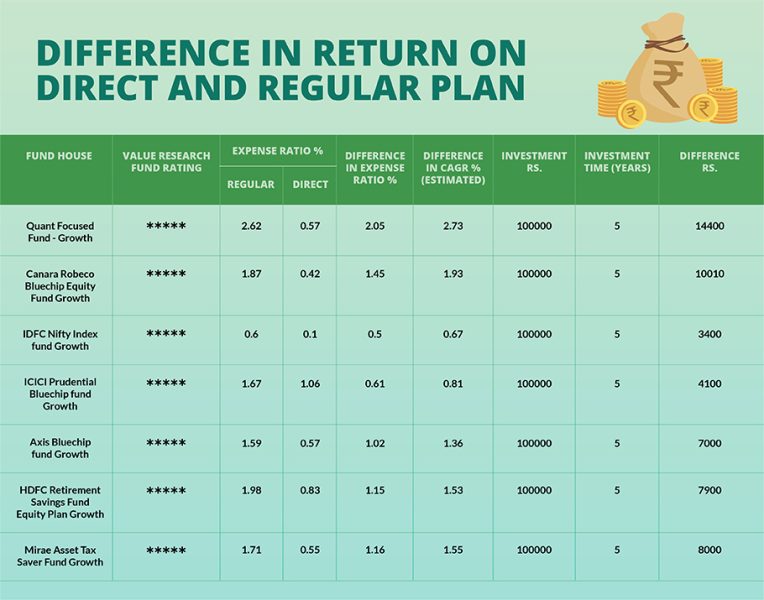
For mutual fund investors, it makes good sense to skip distributors
One can opt for Direct MF schemes for higher returns; we tell you why, and how you can go about it in a prudent manner

Kesavan, who works for a reputed concern, wanted to make some investment in a mutual fund (MF) and sought help from an MF distributor. His friend Ashok also decided to invest in the same scheme. But he made the investment directly in the fund, without engaging a distributor, for the same amount and on the same day.
After some years, to their surprise, Ashok’s fund balance was substantially higher. How did this happen? The difference came about because Kesavan invested through a distributor, while Ashok made a direct investment.
Regular, Direct plans
Every mutual fund scheme has two plans – Direct and Regular. Kesavan opted for a Regular one and Ashok for the Direct. Investment in the Regular mode is done through a distributor who earns a commission, pushing up the expense ratio. This reduces the returns to the investor.
Personal Finance: Post-retirement nest eggs for those who value safety, regularity
In a Direct plan, the investor directly parks his money with the MF and the expense ratio is less. Hence, the ultimate returns on investment is greater.
Total Expense Ratio
For the operating expenses in servicing the investor, a fee known as Total Expense Ratio (TER) is charged to the investor. This is charged proportionately against the assets of the scheme and adjusted in the price or Net Asset Value (NAV) of the unit.
TER includes management fees, registrar’s fees, trustee fees, marketing costs and distribution costs. Distribution cost is the commission paid to the mutual fund distributors.
Direct plan advantageous
Direct plans are bought directly from the Asset Management Company (AMC) and no intermediary is involved. So, there is no distribution cost. The TER is less for Direct plans.
The difference in TERs between Regular and Direct plans can generally range from 0.5 per cent to 1 per cent. This has an immediate effect on the returns of Regular and Direct plans. If the TER of a Regular plan is 0.75 per cent more than that of the Direct plan, the latter gives a 1 per cent higher CAGR (compounded annual growth rate) than the Regular plan.
Let us take some leading MF schemes and compare the two plans to understand the difference in returns. Check out the table given below.

Based on the present TER for these schemes, the difference between Direct and Regular plans has been worked out. The difference in final return has been mapped on the premise that a difference of 0.75 per cent in the TER may work out to a 1 per cent difference in CAGR. A time period of five years has been taken and the amount of investment is taken as ₹1 lakh.
We can notice that higher the difference in TER, the greater the difference in the return. For a longer period of investment, the loss in the Regular scheme will be higher. So, it is better to opt for Direct plan in any MF investment.
Points to remember
Before making an investment under a Direct plan, the investor must know the different schemes available and those suitable for her. As any investment has to be made based on the investment goal and risk appetite, the investor should be in a position to understand these elements.
Personal Finance: Zerodha’s Nithin Kamath gives 5 tips to avoid ‘retirement crisis’
There is enough material available on the internet to evaluate one’s risk appetite. If the investor answers the targeted questions, the risk appetite can be assessed. A risk assessment tool will be helpful for this purpose.
Every MF scheme provides a ‘Riskometer’ categorising the risk of the scheme as Low, Moderately Low, Moderate, Moderately High and High. The investor can select a scheme based on her risk appetite.
Then there are rating agencies like CRISIL, ICRA and Value Research, which analyse MF schemes and provide ratings. These can be taken as a tool to select a fund.
One must remember that the ratings are based on the past performance and present environment and investment in different companies. There is no guarantee that the return on the scheme will be as per the ratings.
Even if one takes the help of a distributor through a Regular scheme, there is no guarantee that the best scheme will be sold. It is perceived that the distributors may try to sell the schemes which offer them better commissions.
Change from Regular to Direct plan
The investor can move from a Regular to Direct plan at any time by placing a request with the AMC. However, this switch will be treated as a normal redemption or switch. If any exit load is applicable, it will be charged. It may also have tax consequences. So, one can do this based on exit road and tax liability.
(The writer is a retired banker. The views expressed here are those of the writer, and do not constitute investment advice.)savan, who works for a reputed concern, wanted to make some investment in a mutual fund (MF) and sought help from an MF distributor. His friend Ashok also decided to invest in the same scheme. But he made the investment directly in the fund, without engaging a distrutor, for the same amount and on the same day.


